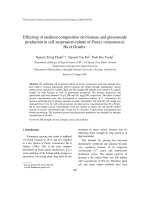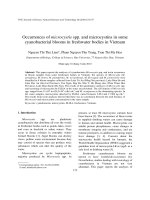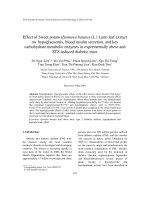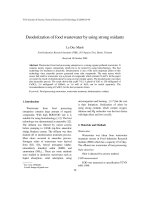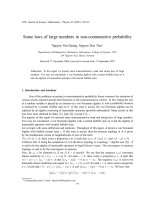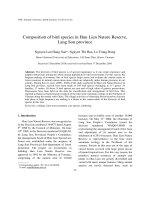Báo cáo "Characteristic of urban wastewater in Hanoi City – nutritive value and potential risk in using for agriculture " docx
Bạn đang xem bản rút gọn của tài liệu. Xem và tải ngay bản đầy đủ của tài liệu tại đây (62.27 KB, 6 trang )
VNU Journal of Science, Earth Sciences 26 (2010) 42-47
42
Characteristic of urban wastewater in Hanoi City – nutritive
value and potential risk in using for agriculture
Chu Anh Dao
1,3
, Pham Manh Con
2,3
, Nguyen Manh Khai
3,
*
1
Institute of Industrial Chemistry, Ministry of Industry and Trade of Vietnam
2
‘Tia Sang’ magazine, Ministry of Science and Technology of Vietnam
3
Faculty of Environmental Sciences, Hanoi University of Science, VNU, 334 Nguyen Trai, Hanoi, Vietnam
Received 9 September 2010; received in revised form 11 October 2010
Abstract. Reusing domestic wastewater for irrigation is a common practice in peri-urban areas in
Vietnam. This study investigates the characteristic of domestic wastewater in Hanoi City in terms
of nutritive value and potential risk in using for agriculture. The wastewater samples were
collected in four main drainage rivers of the City including Lu, Set, Kim Nguu, and To Lich River
during March to May 2010. We found that the wastewater of Hanoi City is seriously polluted by
organic matters. The nutrient parameters were really high and which is suitable for agricultural
irrigation. The wastewater might supply enough nutrients for plant growing. However, municipal
wastewater contains a variety of inorganic substances from domestic and industrial sources,
including a number of potentially toxic elements such as 1.09-2.14 µg Cd L
-1
, 0.16-0.33 mg Cu L
-
1
, 2.75-4.02 µg Pb L
-1
, 0.20-0.34 mg Zn L
-1
and 0.22-0.44 mg Mn L
-1
. These were also a
significant quantities of heavy metals being higher than natural river water, and possible threat to
soil biota and hence on microbial and faunal activity, and then human health.
Keywords: heavy metals, irrigation, trace metals, treatment, wastewater.
1. Introduction
∗
Wastewater is sewage, storm-water and
water that has been used for various purposes
around the community. Unless properly treated,
wastewater can harm public health and the
environment. Urban wastewater pollution
sources are very variables, depending on the
levels of development, population and the
location of the urban area. Most communities
generate wastewater from both residential and
non-residential sources. Other categories of
_______
∗
Corresponding author. Tel.: +84-4-35583306
E-mail:
wastewater sources are generated with four
sources (1) municipal wastewater; (2) industrial
wastewaters, (3) agricultural wastewater and (4)
storm-water runoff [1]. The municipal
wastewater consists of a combination of
domestic wastewater, originating in households,
offices, and public restrooms, and lesser
contributions from many commercial and small
industrial sources [1, 2]. This source brings
potentially nutrient parameters for agriculture
[3, 4].
Reusing urban wastewater for agricultural
production has been applied in many countries
as well as continents [4,5]. In some sub-urban
C.A. Dao et al. / VNU Journal of Science, Earth Sciences 26 (2010) 42-47
43
areas the use of wastewater and sewage sludge
for irrigation and fertilizers is a common
practice and popular [1-6]. Wastewater is often
the only source of water for irrigation. Even in
areas where wastewater source is not the sole
water source for agricultural irrigation, farmers
still prefer using sewage for irrigation, by
reason of its nutritive value, which reduces
expenditure on chemical fertilizer [6].
However, potential toxic substances are
usually found in wastewater, which may limit
the long-term use of wastewater for agricultural
purpose [4,6]. Wastewater is harmful not only
to fish breeding and agricultural products, but
also to public health in surrounding areas [6].
Of the pollutants, heavy metals can endanger
public health by being incorporated into food
chain [7]. Heavy metals are not biodegradable
and tend to accumulate in the sediments of
waterways in association with organic and
inorganic matter in the sediments [8]. In the
present study, we examined the nutritive value
and potential risk of using wastewater of Hanoi
City for agricultural cultivation.
2. Materials and methods
2.1. Study site
The study was carried out in Hanoi, the
capital city of Vietnam. Hanoi City comprises
ten inner city districts and 19 outer city districts
of a total area of 332 490 ha with the population
of 6.3 million people. In Hanoi, the
urbanization process is presently going on very
rapidly. The inner City area is of 198 km
2
, but
the population is concentrated with 2.4 million
people [9]. Especially in this area there are still
many old factories, enterprises, causing serious
environmental pollution that had been warned
by Hanoi environmental protection agency.
However, sewage of Hanoi is a main water
source supplying irrigation water to the peri-
urban areas of Hanoi such as Thanh Tri,
Thuong Tin districts, and some other areas
belonging to Ha Nam province.
This study was mainly concentrated on the
characteristic of wastewater in the inner Hanoi
city. Wastewater samples were taken from the
water drainage rivers system of Hanoi: To Lich
river, Lu river, Set river and Kim Nguu river.
2.2. Study site
The samples are taken along the water
drainage rivers of Hanoi. They are briefly
described in Table 1. Waste water samples were
sampled every two week during March-May
2010 for each site. After sampling the
wastewater samples were stored, and pretreated
for analyzing.
Table 1. Brief description of wastewater samples
Possition
River Location of wastewater sample
Latitude, N Longitude, E
Lu Dinh Cong commune 20°58'34.63" 105°49'58.30"
Set Set bridge 20°58'54.80" 105°50'44.77"
Kim Nguu Mai Dong bridge 20°59'46.37" 105°51'44.29"
Van Dien commune 20°57'14.88" 105°50'28.27"
To Lich Moi bridge 21° 0'4.64" 105°49'5.94"
Dau bridge 20°58'11.36" 105°49'28.78"
C.A. Dao et al. / VNU Journal of Science, Earth Sciences 26 (2010) 42-47
44
2.3. Method of analyzes
Wastewater samples were analyzed for pH,
chemical oxygen demand (COD), N, P, K, Cd,
Cu, Pb and Zn. pH was measured by using pH
meter immediately after sampling, chemical
oxygen demand (COD) was used K
2
Cr
2
O
7
method. Metal concentrations were analyzed for
P, K, Cd, Cu, Pb and Zn after digestion with
boiling concentrated HNO
3
[10]. Total N (N
total
)
was quantified as the sum of four N forms:
nitrate-N (NO
3
-
-N), nitrite-N (NO
2
-
-N),
ammonium-N (NH
3
-N) and organic-N (N
org
).
NO
2
-
-N and NO
3
-
-N were determined
colorimetrically, NH
3
-N was determined by a
titration method after distillation, and N
org
was
determined by macro-Kjeldahl methods [10].
3. Results and discussion
3.1. River - drainage system in Hanoi City
The four rivers are playing a very important
role in water drainage in Hanoi inner. The
lengths and basin areas of these rivers are
shown in the following table (Table 2).
Table 2. Characteristics of water drainage rivers of Hanoi
No Name
of river
Basin area
(ha)
Length
(km)
Wide
(m)
Begin of river End of river
1 Lu 560 5.8 20-30 Trinh Hoai Duc Dinh Cong commune (To Lich river)
2 Set 580 6.7 10-30 Tran Khat Tran Giap Nhi commune (To Lich river)
3 Kim Ngu 1400 12.2 25-30 Lo Duc Son bridge (To Lich river)
4 To Lich 2000 14.8 30-40 Phan Dinh Phung To bridge
Total 4540 39.5 10-40
Lu river:
Lu river is 5.8 km long, 20-30 m wide, 4m
deep, derived from Trinh Hoai Duc sluice,
flowing through Dong Da lake, Trung Tu lake,
Linh Dam lake and to To Lich river in Dinh
Cong commune. Lu river basin area is 560 ha
with a population of 200 thousand people. The
volume of sewage discharged into the river
ranges from 50,000 – 55,000 m
3
day
-1
.
Set river:
Set river is derived from Tran Khat Chan
sluice, flowing through Hanoi Technical
University, Dai La bridge, and in to Kim Nguu
river in Giap Nhi commune. The river is 6.7 km
long, 10-30 m wide in average, 3-4 m deep. The
basin area of Set river is 580 ha with a
population of 250 thousand people. The totals
of wastewater discharged in to the river ranges
from 65,000-70,000 m
3
day
-1
.
Kim Nguu river:
The river is derived from Lo Duc sluice,
12.2 km long, receives all sewage from the
basin of Lo Duc, Quynh Loi, Mai Huong, Vinh
Tuy with a total basin area of more than 1,400
ha and a population of more than 500 thousand
people. Kim Nguu river merges into To Lich
river at Son bridge closer to Thanh Liet dam.
Kim Nguu river from the inner city is about
90,000 – 105,000 m
3
day
-1
.
To Lich river:
The To Lich river begins at the West Lake
and flows into the Nhue River. To Lich river is
the main drainage river of Hanoi’s inner city.
Sewage from the 3 rivers above is discharged
into To Lich river. The river begins from Phan
Dinh Phung sluice, through channels Thuy
Khue, Buoi, Cau Giay, Cau Moi to Thanh Liet
dam, discharged into Nhue river at To bridge or
C.A. Dao et al. / VNU Journal of Science, Earth Sciences 26 (2010) 42-47
45
flowing to Hoa Binh dam in the south of Hanoi.
The river is 14.8 km long, 30 – 40 m wide, 3-4
m deep. The main basin area, excluding the
basin area of the 3 rivers above, is 2,000 ha, the
sewage flow is of 110,000- 125,000 m
3
day
-1
,
with a population of more than 560 thousand
people.
3.2. Wastewater characteristics
The results of wastewater analyzes are
presented in Table 3.
Table 3. Characteristic of wastewater in drainage river system of Hanoi City
Lu river Set river
Kim Nguu river To Lich river
N
o
Parameters
Unit
Dinh Cong
commune
Set
bridge
Mai Dong
bridge
Van Dien
commune
Moi
bridge
Dau
bridge
1 pH 7.43±0.22
7.49±0.25
7.56±0.29 7.53±0.25
7.57±0.31
7.44±0.31
2 SS mg L
-1
117±24
75±27
57±14 72±18
112±20 151±30
3 COD mg O
2
L
-1
123±41
125±34
118±17 67±7
101±40 119±51
4 N
total
mg N L
-1
12.2±4.7
12.7±4.8
12.8±5.0 8.0±3.4
13.1±4.4
13.1±3.4
5 P
total
mg P L
-1
3.8±1.2
3.7±1.1
3.4±1.2 3.3±0.9
3.6±1.4 3.7±1.4
6 K
total
mg K L
-1
11.4±3.4
10.3±1.9
11.8±2.2 9.6±2.7
11.7±1.8
13.2±2.1
7 Cd µg Cd L
-1
1.19±0.89
1.11±0.89
1.32±0.94 2.14±1.88
1.59±1.03
1.09±0.98
8 Pb µg Pb L
-1
3.92±1.44
3.53±1.46
3.54±1.39 4.02±1.55
4.45±1.94
2.75±1.05
9 Cu mg Cu L
-1
0.25±0.09
0.22±0.10
0.27±0.09 0.33±0.08
0.32±0.15
0.16±0.07
10
Zn mg Zn L
-1
0.25±0.12
0.24±0.12
0.30±0.17 0.32±0.17
0.34±0.17
0.20±0.11
11
Mn mg Mn L
-1
0.32±0.09
0.29±0.10
0.35±0.12 0.42±0.15
0.44±0.17
0.22±0.06
pH, SS and COD
The water quality determined is
summarized in Table 3. The pH ranged between
7.20 and 7.87. The chemical oxygen demand
(COD) and suspended solid (SS) in water were
high, and much higher than the maximum
allowable concentration of National technical
regulation on surface water quality, QCVN
08:2008/BTNMT column B1 [11].
Nutrient parameters: N, P, K
The result obtained from analyzes of
nutrition criteria in water at the studied area
shows that total nitrogen (N
total
) ranged from 4.6
to 17.8 mg L
-1
, the average value was 11.9 mg
L
-1
. Potassium (K) content in water was also
relatively high, ranging from 4.1 – 17.3 mg L
-1
,
the average value was 11.3 mg L
-1
. Total
phosphorus content (P
total
) ranged from 1.0 – 6.7
mg L
-1
, the average value was 3.6 mg L
-1
.
Considering the aspects of nutrition and
availability of using sewage as irrigation water,
wastewater of Hanoi contains high content of
nutrients suitable for reuse of agricultural
irrigation. Normally, nutrients parameters of
urban wastewater are higher than those in
natural water. A comparison of nutrient
parameter in the river wastewater system to Red
river water found that the N
total
, P
total
and K
total
in
urban wastewater was 3.5, 7.1 and 10.9 times
respectively higher than the Red River water
[5].
Heavy metals
The concentration of heavy metals
including cadmium (Cd), lead (Pb), and copper
(Cu) in urban wastewater is presented in Table
3. The mean value heavy metal contents ranged
C.A. Dao et al. / VNU Journal of Science, Earth Sciences 26 (2010) 42-47
46
from 1.09 – 2.14 µg L
-1
for Cd, 2.75-4.02 µg L
-1
for Pb, and 0.16-0.33, 0.20-0.34, 0.22-0.44 mg
L
-1
for Cu, Zn, Mn respectively.
Valuable of nutrients and potential risk
The results in Table 2 and Table 3 showed
that in average, every 1 m
3
of wastewater
contains 13.76 g for N; 3.64 g for P and 11.58 g
for K, this is a very good nutrient supply
source. Based on appropriate nutrition demand
of rice and maize, as well as the volume of
irrigation water necessary for 1 crop, the
capacity of supplying nutrients of sewage is
shown in the following Fig 1.
48.16
13.55
96.32
27.09
0
20
40
60
80
100
120
Wastewater Natural water
L
H
Recomended N for maize
(100 kg ha
-1
)
Recomended N for rice
(89,6 kg/ha)
N
12.74
2.60
25.48
3.64
0
5
10
15
20
25
30
Wastewater Natural water
L
H
Recomended P for maize
(26.67 kg ha
-1
)
Recomended P for rice
(18.98 kgha
-1
)
P
40.53
3.71
81.06
7.42
0
10
20
30
40
50
60
70
80
90
Wastewater Natural water
L
H
Recomended K for rice
(41.24 kgha
-1
)
Recomended K for maize
(24.89 kg ha
-1
)
K
Fig 1. A comparison of capacity supplying nutrients
for N, P, K by using wastewater and river water for
irrigation (kg ha
-1
). Two horizontal lines show the
nutrition demand for N, P, K of rice and maize. H
and L indicated the demand supplying of water
being high level (7000 m
3
ha
-1
) and low level (3500
m
3
ha
-1
), respectively.
Fig 1. showed the capacity of supplying
nutrients through wastewater for agriculture is
very high. In many case, the wastewater
supplies enough nutrient for plant growing.
However, municipal wastewater contains a
variety of inorganic substances from domestic
and industrial sources, including a number of
potentially toxic elements such as arsenic (As),
Cd, chromium (Cr), Cu, mercury (Hg), Pb, Zn,
etc [12]. The present study found that a cubic
meter of wastewater contained about 1.09-2.14
mg Cd; 0.16-0.33 g Cu; 2.75-4.02 mg Pb, 0.20-
0.34 g Zn and 0.22-0.44 g Mn. These were also
significant quantities of heavy metals, and
possible threats to human health [7]. Even if the
toxic materials in wastewater are not present in
concentrations likely to affect humans or to
limit their agricultural use, they might be higher
than concentrations in natural river water,
which would lead to contamination of
agricultural soils in the long-term [14]. Wang
(2005) studied the impact of sewage irrigation
C.A. Dao et al. / VNU Journal of Science, Earth Sciences 26 (2010) 42-47
47
on trace metal contamination in Beijing and
stressed that metals were enriched in soil due to
sewage irrigation. This was also the conclusion
in earlier publications regarding the potential
risk of sewage irrigation on soils, crop
production and human health [5-8, 12-14].
4. Conclusion
Wastewater characteristic of Hanoi city was
polluted with organic matter. The nutrient
parameter was really high and suitable for
agricultural irrigation. The wastewater might
supply enough nutrients for plant growing.
However, municipal wastewater contains a
variety of inorganic substances from domestic
and industrial sources, including a number of
potentially toxic elements such as 1.09 - 2.14
µg Cd L
-1
, 0.16 - 0.33 mg Cu L
-1
, 2.75 - 4.02 µg
Pb L
-1
, 0.20 - 0.34 mg Zn L
-1
and 0.22 - 0.44
mg Mn L
-1
. These were a significant quantity of
heavy metals, and possible threats to soil biota,
and then human health.
References
[1] R.H. Kadlec, R.L. Knight, Treatment wetlands.
New York, Lewis Publishers, 1996.
[2] E. Friedler, D. Butler, Quantifying the inherent
uncertainty in the quantity and quality of
domestic wastewater. Water Science and
Technology 33 (1996) 65-78.
[3] N.M. Khai, P.Q. Ha, I. Oborn, Nutrient flows in
small-scale peri-urban vegetable farming
systems in Southeast Asia - a case study in
Hanoi, Agriculture, Ecosystems & Environment
122 (2007) 192-202.
[4] L.Raschid-Sally, D.D. Tuan, A. Sarath, National
assessments on wastewater use in agriculture
and an emerging typology: the Vietnam case
study. In: Wastewater use in irrigated
agriculture: confronting the livelihood and
environmental realities. (Ed. C.A. Scott). CABI
Publishing. Cambridge, MA, USA. 2004, pp. 81-
90.
[5] N.M. Khai, P.T. Tuan, N.C. Vinh, I. Oborn.
Effects of using wastewater as nutrient sources
on soil chemical properties in peri-urban
agricultural systems, VNU Journal of Science,
Earth Sciences 24 (2008) 16-25.
[6] V. Lazarova, T. Asano, Challenges of
Sustainable irrigation with recycled water, in V.
Lazarova, A. Bahri, Water reuse for irrigation,
Agriculture, Landscapes and Turf Grass, CRC
Press, London New York, 2005, 1-30.
[7] L.A. Nguyen, N.D. Minh, N.M. Khai, N.C.
Vinh, R.L. Hough, I. Oborn, Potential public
health risks due to dietary intake of lead (Pb)
from rice in a metal recycling village in Bac
Ninh province in the Red River delta, VNU
Journal of Science, Natural Sciences and
Technology 26 (2010) 95-103.
[8] M.B. Pescod, Wastewater treatment and use in
agriculture, Food and Agriculture Organization.
Rome, 1992.
[9] Hanoi statistical Office, Hanoi Statistical
Yearbook. City Statistical Office, Hanoi, 2009.
[10] Eaton, A.D., Clesceri, L.S., Greenberg, A.E.,
(Eds.), Standard methods for examination of
water and wastewater. 19
th
Edition. American
Public Health Association, Washington 1995.
[11] MONRE, National technical regulation on
surface water quality, 2008.
[12] M. Muchuweti, J.W. Birkett, E. Chinyanga, R.
Zvauya, M.D. Scrimshaw, J.N. Lester, Heavy
metal content of vegetables irrigated with
mixtures of wastewater and sewage sludge in
Zimbabwe: implications for human health.
Agriculture, Ecosystems & Environment 112
(2006) 41-48.
[13] X.J. Wang, Kriging and heavy metal pollution
assessment in wastewater irrigated agricultural
soil of Beijing's eastern farming regions. Journal
of Environmental Science and Health Part A-
Toxic/Hazardous Substances & Environmental
Engineering 33 (1998) 1057-1073.
[14] R. Mapanda, E.N. Mangwayana, J. Nyamangara,
K.E. Giller, The effect of long-term irrigation
using wastewater on heavy metal contents of
soils under vegetables in Harare, Zimbabwe.
Agriculture, Ecosystems & Environment 107
(2005) 151-165.


